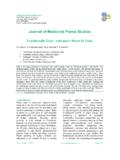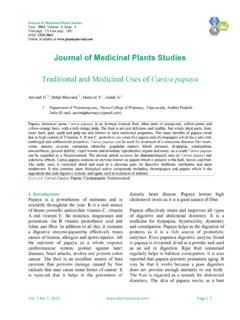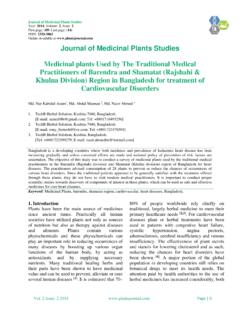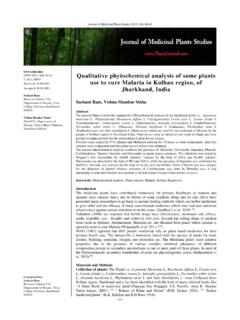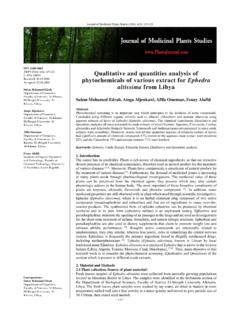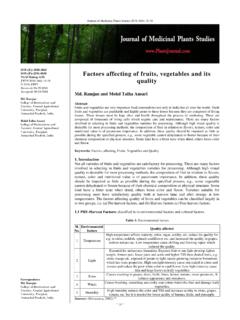Transcription of Journal of Medicinal Plants Studies
1 Journal of Medicinal Plants Studies Year: 2013, Volume: 1, Issue: 4. First page: (32) Last page: (37). ISSN: 2320-3862. Online Available at Journal of Medicinal Plants Studies Ethnobotanical Study of Traditional Medicinal Plants Used by Indigenous People of Gemad District, Northern Ethiopia Kalayu Mesfin 1*, Gebru Tekle 2, Teklemichael Tesfay 3. 1. Biology Department, Aksum University, Box: 1010, Fax: +251-347-75-19-31 Aksum, Ethiopia, [E-mail: 2. Biology Department, Aksum University, Box: 1010, Fax: +251-347-75-19-31 Aksum, Ethiopia, [E-mail: 3. Biology Department, Aksum University, Box: 1010, Fax: +251-347-75-19-31 Aksum, Ethiopia, [E-mail: Ethnobotanical study on traditional Medicinal Plants were conducted between April and May, 2013 in Tabiya Gemeda district and documented different types of traditional Medicinal Plants used by the indigenous peoples. The study was focused on identifying Medicinal Plants , disease treated, part of the plant used, methods of preparation, route of administration, ingredients added etc.]]]
2 The data was collected using interview and questionnaires by selecting 16 healers using purposive sampling method. A total of 31 Medicinal plant species were collected and identified from the study area for treating 32 human aliments. Out of these 18(58%) were wild where as 11( ). of them were cultivated and 2( ) were wild and cultivated Plants . The most dominant plant part was leaf (50. %). The route of administration was oral administration about 20( ) and the most common method of preparation is grinding about 7( ). Keyword: Ethnobotany, Indigenous Knowledge, Aliments, Medicinal Plants , Tabia Gemad, Healers 1. Introduction the country use plant based traditional medicine Ethnobotany is the study of the interaction by indigenous knowledge as their major primary between Plants and people, with a particular health care system[3]. emphasis on traditional tribal cultures. According Traditional knowledge of Medicinal Plants and to the World Health Organization (WHO) about their use by indigenous healers and drug 65-80% of the world's population in developing development in the present are not only useful for countries depends essentially on Plants for their conservation of cultural tradition and biodiversity primary healthcare due to poverty and lack of but also for community health care and drug access to modern medicine[1].
3 About 80% of the development in the local people. The indigenous total population of Ethiopia is depending on knowledge on Medicinal Plants appears when traditional medicine to treat different types of humans started and learned how to use the human ailments[2]. traditional knowledge on Medicinal Plants [4]. They use their perceptions and experiences to The lack of conservation actions and activities is categorize plant species indigenously and local observed in klete Awlaelo woreda, which is people over the past period take traditional similar to other areas of Ethiopia. Even though it medicine. is known the Woreda has relatively better plant Traditional Medicinal practices are common in resource and associated traditional knowledge Ethiopia in which about 80% of the population in resource is expected to be significant. The current Vol. 1 No. 4 2013 Page | 32. Journal of Pharmacognosy and Phytochemistry plant use trend shows that the environment is of Tigray regional state. The total area of the facing problems of resource depletion and loss of study site accounts about 249km2.
4 Major activity indigenous knowledge like other area of the of the local people depends on agriculture and country. Thus concerned ethno botanical research they do not have access to medical service. plays an important role for conservation and sustainable utilization of these Medicinal Plants . 3. Sample Size and Sampling Techniques In different parts of Tigray, Medicinal Plants have In this study one kebele was selected from the been used as traditional medicine to treat area using purposive sampling techniques. This is different human ailments. People who live in because the kebele is mostly covered by different these areas have traditional knowledge on use of plant species and these Plants are used for Medicinal plant species. However, it is not widely traditional Medicinal value to treat different used as it could be because the skills are fragile diseases. The researcher selected 16 healers using and not written document (easily forgettable) as purposive sampling technique to gather the most of the Medicinal Plants are in the hands of a relevant data.
5 Handful and kept as a secret[5]. Therefore, the present study was conducted to assess and 4. Data Collection document the knowledge and use of Medicinal Ethnobotanical data was collected between April plant species used by the traditional healers to 2013 to May 2013 on sixteen individual healers treat different human ailments in Wukiro kiltie were interviewed using semi-structured awulaelo. The study focuses in identifying the interviews and observations. The information parts of Plants used for Medicinal purposes, their collected included local name of the traditional mode of preparation, ingredients added and other Medicinal plant, type (cultivated or wild), use of the plant. diseases treated, parts used, condition of plant used, method of preparation, route of 2. Materials and Methods administration, ingredients added, other uses of The study was conducted in Woreda Wukro klete the plant and existing threats to Medicinal Awlaelo specifically in Gemeda district which is species. Finally, the data were analysis using found in eastern zone of Tigray regional state, descriptive statistics.
6 Northern Ethiopia. The study area is located 52km far from north of Mekelle which is the capital city Table 1: List of Medicinal Plants , Disease Treated, Ingredients Added and Condition of plant used and other uses of Medicinal Plants in the Study Area Condition of the Ingredients add Scientific name Disease treated Local name of Other uses of of Medicinal Medicinal Medicinal Medicinal Plants Plants Plants Plants S. No Anti bacterial 1 Aftuh Plumbago zeylanica Dry None None infection 2 Duba Cucurbita maxima Dry Tap worm None Used as source of food 3 Mezerbae Datura stramonium Fresh Wound None Used for fertilizer Anti 4 Limo/nim Azadirachta indica Fresh None None insecticides 5 Shibti Phytolacca dodecandra Fresh Abortion None Used for Washing cloth 6 Ere Aloe vera Fresh Diabetes None Source of food for animal 7 Awhi Cordia africana Fresh Acute febrile Coffee As a source of food and wood Vol. 1 No. 4 2013 Page | 33. Journal of Pharmacognosy and Phytochemistry illness(AFI). 8 Agol Withania somnifera Fresh Hepatit Garlic None Abdominal.
7 9 Tikur-berbere Schinus molle Fresh Water None Cramp/colic Tseada Common cold, None Used for a source of food in the 10 Allium sativum Fresh Shingurti Malaria form of spices 11 Gesho Rhamnus prinoides Dry Dandruff None Used for preparation of tella . Used for a source of food and 12 Agam Carissa edulis Dry Goiter None wood Pancreas 13 Shenfae Lepidium sativum Dry/fresh None None disease 14 Kinchib Euphorbia tirucalli Drsy/fresh Warts Butter Food for animal 15 Harmazo Flueggea virosa Powder Spider poison Water Used for a source of food 16 Awesda Nigella sativa Fresh Bandit Tella None 17 Gaba Ziziphus spina-christi Fresh stomach pain Honey Food source 18 Papayo Carica papaya Fresh amoebas None Food source 19 Lemon Citrus limon Fresh Diarrhea Sugar None 20 Shilan Foeniculum vulgare Fresh Anuria None None 21 Engule Solanum incanum Dry Twinge None None 22 Shingurti zibe Albuca abyssinica Dry Rheumatism None None 23 Shashito Tragia cinerea Liquid Skin damage None None 24 Hafafo Cucumis dipsaceus Fresh Eyeblindness Water None Euphorbia 25 Kolkal Liquid TB None None candelabrum Crown of the 26 Micheale Achyromaspera Fresh None None head Fire burning 27 Tirnaka Verbascum sinaiticum Fresh None None Body 28 Moqmoqo Rumex abyssinicus Dry
8 Vomiting None Use for teased for food Used for food for soking kita 29 Awlie Ovia Euroia Fresh Gardoa None for preparation of Tella Acute febrile 30 Demakase Ocimun laminafollum Fresh Coffee None illness(AFI). 31 Tambok Croton macrostachyus Dry/fresh Rabies Water None As indicated from the above table a total of 31 washing cloth, for preparation of traditional Medicinal plant species were collected and alcohol Tella , for fair wood, for smoking milk identified by the researchers from the study area and others. A previous study by[6] was agreed (table 1). Those 31 Medicinal plant species were with the present findings regarded with the other treated around 32 different human ailments. important of Medicinal Plants . Some of the Medicinal Plants were added different ingredients but around of the Plants were not adding any ingredient to treat human ailments. The healers responded that Coffee, Garlic, Water, Butter, Tella, Honey and Sugar were some of the ingredients added to the Medicinal Plants in different mode of preparation.
9 The present study was in line with previous findings of[4] related with the ingredients added. The above listed Medicinal plant species were also used for different purposes in addition to the disease treatment like for food source for human and different animals, use as fertilizer, for Vol. 1 No. 4 2013 Page | 34. Journal of Pharmacognosy and Phytochemistry Figure 1: Source of Medicinal Plants in the study from the wild. In various parts of the world, area Medicinal Plants are mostly harvested from the Previous Studies of[4] in Inderta woreda south- wild sources either for local use or trade eastern Tigray, northern Ethiopia indicated that purposes[8]. But the present finding showed that ( ) of the traditional Medicinal Plants were 18 species (58%) were wild, 11 species wild while 5 species ( ) were gotten from were collected from cultivated and only 2species cultivation and the remaining 5 species ( ) ( ) were both wild and cultivated ( ). So were obtained both from cultivation and the wild the present finding was agreed with the previous and[7] reported that ( ) of the Medicinal finding of [8].
10 Plants in Wonago Wereda, Southern Ethiopia was Figure 2: Rout administration of Medicinal by dermal and the rest 3 species ( ) of plant`s remedies for human ailments in the study Medicinal Plants also taking both by oral and area. dermal mode of application. So this finding As figure two indicated that 20 species ( ) showed that the highest mode rout administration of the Medicinal Plants were taking by oral, about of these Medicinal Plants were oral. 8 species ( ) of Medicinal Plants were taking Vol. 1 No. 4 2013 Page | 35. Journal of Pharmacognosy and Phytochemistry Figure 3: plant part used in the preparation of total uses. This was followed by fruits (19%), remedies in the study area. roots (15%), seeds (12%), and barks (2%). The above pie chart indicated that 42% part of Such wide harvesting of leaves for traditional the Medicinal plant species used to treat human medicine compared to roots in the study area aliments was leaf. However, only 6% of stem which are important for survival of Plants has a parts were used as traditional Medicinal value in less negative influence on the survival and the study area.
